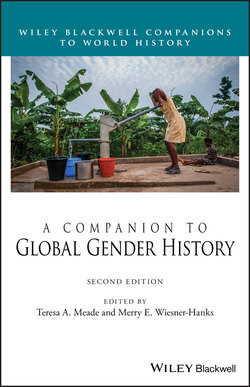Читать книгу A Companion to Global Gender History - Группа авторов - Страница 51
Concepts of Women, Sex, and Gender
Оглавление“Women” might at first glance have a more stable meaning than “race,” but here, too, bodily and cultural understandings have clashed and overlapped. In the 1980s, scholars in many fields began to differentiate between “sex,” by which they meant physical, morphological, and anatomical differences (what are often called “biological differences”), and “gender,” by which they meant a culturally constructed and historically changing system of differences. But just at the point that scholars were beginning to see the distinction between sex and gender (and an increasing number were accepting the importance of gender as a category of analysis), that distinction became contested. Not only were there great debates about where the line should be drawn – the age‐old debate of nature versus nurture – but some scholars wondered whether social gender and biological sex are so interrelated that any distinction between the two is meaningless. For example, although most people are categorized “male” or “female” at birth when someone looks at their external genitalia, some have more ambiguous sex organs. The gender polarity man/woman has been so strong, however, that such intersex persons were usually simply assigned to the sex they most closely resembled. Since the nineteenth century, surgical procedures, generally shortly after birth, have been used to modify or remove the body parts that did not fit. Thus, cultural norms about gender (that everyone should be a man or a woman) determine sex in such cases, rather than the other way around. Judith Butler argued in Gender Trouble that sex is not prior to gender; rather, sex “ought to be understood as an effect” of cultural constructions of gender (1990: 6; emphasis added). Her theory suggests that “rather than being the expression of sex, or the cultural production of sex … gender, in fact, regulates the notion that sex is the natural condition of the human body” (177; emphasis added).
Trans individuals have challenged the arbitrary and culturally constructed nature of sex. In the 1950s, sex‐change operations became available for people whose external genitalia and even chromosomal and hormonal patterns marked them as male or female but who mentally understood themselves to be the other. Transsexual surgery could make the body fit more closely with the mind, but it also led to challenging questions about the role of the body and bodily processes in gender. Butler and others had emphasized the cultural construction of gender (and sex), but some theorists returned to the body as a key site of difference. Bernice L. Hausman, for example, sought “to show how transsexuals compromise the official understanding of ‘gender’ as divorced from biological sex by their insistent reiteration of the idea that physiological intersexuality is the cause of their cross‐sex identification” (1995: 141; emphasis added). Others downplayed the link between physiological intersexuality and trans identity, particularly as some individuals came to understand “trans” to mean not only moving from one gender to the other, but also as neither male nor female or both male and female or in some way outside a dichotomous gender system.
Individuals outside the dichotomous gender system are not something new, but have existed in many cultures in the past. Studies of third and trans genders in history are proving politically useful, as people within the LGBTQ+ (lesbian, gay, bisexual, trans, queer/questioning, plus) and trans movements today use them to demonstrate the variety in understandings of gender and sexuality, and to stress that demands for rights for homosexuals or third gender individuals are not simply a Western import. In this they looked to examples of third or even fourth and fifth genders around the world, such as what are now usually termed “two‐spirit people” among Native Americans, individuals who often had (and in some cases still have) special religious and ceremonial roles because they were regarded as having both a male and female spirit rather than the more common single spirit (Rifkin, 2011).
To questions about the category “woman” that come from intersex and trans individuals are those that come from other categories of difference. As feminist scholars put increasing emphasis on differences among women, Butler and others have wondered whether it made sense to talk about “women” at all (1990: 14). Similarly, Mohanty argues against the notion that women constitute a “coherent group with identical interests and desires regardless of class, ethnic or racial location, or contradictions” since that implies “a notion of gender or sexual difference, or even patriarchy, which can be applied universally and cross‐culturally” (2003: 55). The problem with this essentialist thinking is that women are constituted prior to entry into specific social, cultural, and historical contexts. Like race, women, sex, and gender are thus terms whose meanings are unstable and murky. Nonetheless, activists could argue that the contention that gender, or even “women,” are merely cultural constructs erases the very real oppression that many women experience. They have extended Higgenbotham’s idea of race as a discursive tool for liberation and Spivak’s of strategic essentialism to gender, recognizing that this is essential for understanding intersectional oppression, and using this knowledge as a basis for engaged scholarship or activism.
